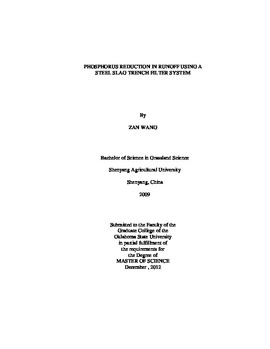| dc.contributor.author | Wang, Zan | |
| dc.date.accessioned | 2014-04-15T22:06:30Z | |
| dc.date.available | 2014-04-15T22:06:30Z | |
| dc.date.issued | 2012-12-01 | |
| dc.identifier.uri | https://hdl.handle.net/11244/9383 | |
| dc.description.abstract | Excessive concentrations of phosphorus (P) can lead to the deterioration of surface waters by eutrophication. The objective of this study was to evaluate the performance of a steel slag trench filter system developed for P reduction in runoff under field conditions. The experimental design for the study was a 2 x 2 factorial with factors of filter material (6 mm steel slag or 13 mm washed river gravel) and triple superphosphate fertilizer (P applied or no P applied) replicated within irrigation zones covered with `Astro' bermudagrass [Cynodon dactylon L. (Pers.)] mowed at 38 mm. Each irrigation block consisted of four plots that were 6.1 m wide with a uniform 5% slope that measured 24.4 m long. Four plastic containers (volume = 178 L each) were placed in a 5.2 m 1.2 m trench dug in the middle of each plot perpendicular to the slope to accommodate filter materials. Runoff caused by either natural rainfall or irrigation was collected for comparison of P concentrations before and after filtration. Flow rates were determined using ultrasonic depth detection devices as runoff flowed through calibrated Parshall flumes. From March through September 2012 a total of 14 runoff events were studied. Runoff filtered by steel slag contained from 17% to 43% less dissolved P than runoff filtered through an inert gravel control. The P concentrations in runoff from the fertilized treatment were always greater than the unfertilized treatment. The difference between P concentrations from the fertilized and unfertilized treatments declined with each runoff event from 9.48 mg L-1 in the initial event after fertilization to 0.20 mg L-1, 120 d and nine runoff events later. A previous P removal model developed by Penn and McGrath (2011) overestimated the maximum P loading potential of the slag filter structures (460 mg kg-1 vs. 269 mg kg-1 calculated from actual data), as well as the maximum P removal before the filters were spent (35.7 mg kg-1 vs 8.3 mg kg-1). The overestimation of the performance of the P removal structure probably occurred because the slag used in this study had "inferior" P sorption qualities than that used for model development. | |
| dc.format | application/pdf | |
| dc.language | en_US | |
| dc.publisher | Oklahoma State University | |
| dc.rights | Copyright is held by the author who has granted the Oklahoma State University Library the non-exclusive right to share this material in its institutional repository. Contact Digital Library Services at lib-dls@okstate.edu or 405-744-9161 for the permission policy on the use, reproduction or distribution of this material. | |
| dc.title | Phosphorus Reduction in Runoff Using a Steel Slag Trench Filter System | |
| dc.type | text | |
| osu.filename | Wang_okstate_0664M_12501.pdf | |
| osu.college | Agricultural Sciences and Natural Resources | |
| osu.accesstype | Open Access | |
| dc.description.department | Department of Plant and Soil Sciences | |
| dc.type.genre | Thesis | |
| dc.subject.keywords | fertilizer | |
| dc.subject.keywords | filter | |
| dc.subject.keywords | phosphorus | |
| dc.subject.keywords | runoff | |
| dc.subject.keywords | slag | |
| dc.subject.keywords | turfgrass | |
